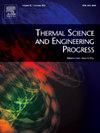Thermal interface materials: A promising solution for passive heat dissipation in electronic appliances
IF 5.1
3区 工程技术
Q2 ENERGY & FUELS
引用次数: 0
Abstract
The rapid progress of wireless technology, accompanied by the continuous miniaturization of electronic devices, has significantly increased power density, posing serious challenges to thermal management. Upholding stable thermal performance in compact devices requires highly efficient thermal interface materials (TIMs) having the capability of reliable heat dissipation. This review critically analyzes the main categories of TIMs used in electronic packaging cooling, highlighting their thermal characteristics, operational limitations, and common issues, such as pump-out and phase separation in conventional materials (greases, gels, adhesives, and thermal pads). Special attention is paid to nano-enhanced phase change materials (NePCMs), which combine the high latent heat of PCMs with the superior thermal conductivity of embedded nanoparticles e.g., carbon, metals. The review is organized into sections covering: (i) the fundamental properties of conventional TIMs and NePCMs, (ii) the types of nanoparticles used in various classes of PCMs and their effects on thermophysical properties like thermal conductivity, latent heat capacity, melting point, and (iii) the main challenges related to the integration of NePCMs in electronic packaging. In conclusion, the need for advanced optimization strategies is highlighted to fully exploit the potential of NePCMs in the thermal management of future high-energy-density devices.

热界面材料:一种很有前途的电子设备被动散热解决方案
无线技术的快速发展,伴随着电子器件的不断小型化,使得功率密度显著增加,对热管理提出了严峻的挑战。在紧凑型设备中保持稳定的热性能需要具有可靠散热能力的高效热界面材料(TIMs)。本文批判性地分析了用于电子封装冷却的TIMs的主要类别,强调了它们的热特性,操作限制和常见问题,例如传统材料(润滑脂,凝胶,粘合剂和热垫)的泵出和相分离。特别关注的是纳米增强相变材料(NePCMs),它结合了PCMs的高潜热和嵌入纳米颗粒(如碳,金属)的优越导热性。该综述分为几个部分,包括:(i)传统的TIMs和nepcm的基本特性,(ii)在不同类型的pcm中使用的纳米颗粒类型及其对热物理特性的影响,如导热性,潜热容,熔点,以及(iii)与nepcm集成在电子封装中的主要挑战。总之,需要先进的优化策略来充分利用nepcm在未来高能量密度器件热管理中的潜力。
本文章由计算机程序翻译,如有差异,请以英文原文为准。
求助全文
约1分钟内获得全文
求助全文
来源期刊

Thermal Science and Engineering Progress
Chemical Engineering-Fluid Flow and Transfer Processes
CiteScore
7.20
自引率
10.40%
发文量
327
审稿时长
41 days
期刊介绍:
Thermal Science and Engineering Progress (TSEP) publishes original, high-quality research articles that span activities ranging from fundamental scientific research and discussion of the more controversial thermodynamic theories, to developments in thermal engineering that are in many instances examples of the way scientists and engineers are addressing the challenges facing a growing population – smart cities and global warming – maximising thermodynamic efficiencies and minimising all heat losses. It is intended that these will be of current relevance and interest to industry, academia and other practitioners. It is evident that many specialised journals in thermal and, to some extent, in fluid disciplines tend to focus on topics that can be classified as fundamental in nature, or are ‘applied’ and near-market. Thermal Science and Engineering Progress will bridge the gap between these two areas, allowing authors to make an easy choice, should they or a journal editor feel that their papers are ‘out of scope’ when considering other journals. The range of topics covered by Thermal Science and Engineering Progress addresses the rapid rate of development being made in thermal transfer processes as they affect traditional fields, and important growth in the topical research areas of aerospace, thermal biological and medical systems, electronics and nano-technologies, renewable energy systems, food production (including agriculture), and the need to minimise man-made thermal impacts on climate change. Review articles on appropriate topics for TSEP are encouraged, although until TSEP is fully established, these will be limited in number. Before submitting such articles, please contact one of the Editors, or a member of the Editorial Advisory Board with an outline of your proposal and your expertise in the area of your review.
 求助内容:
求助内容: 应助结果提醒方式:
应助结果提醒方式:


